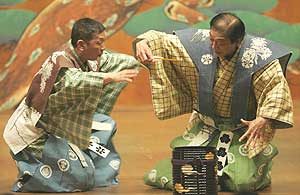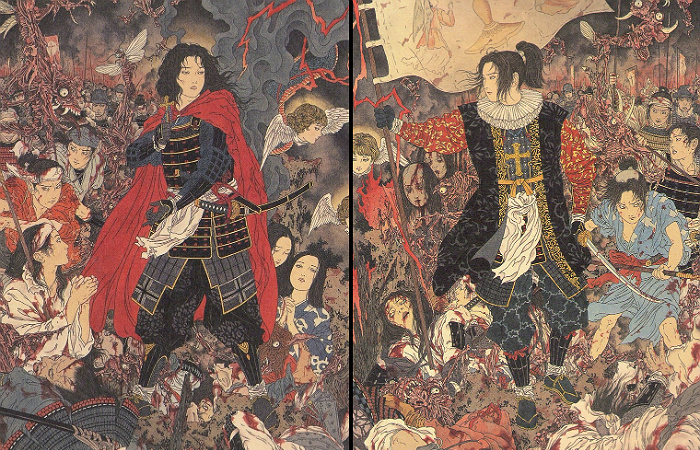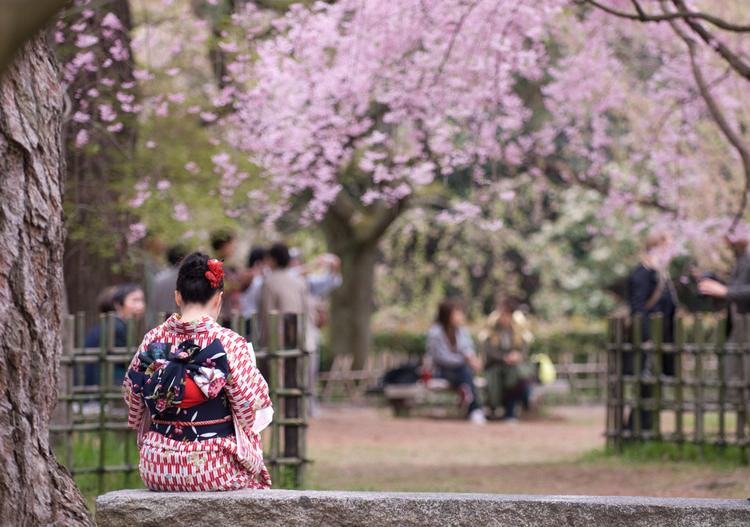ABOUT KOGEN THEATER
 The Kyogen Theater, of which we are actors, is the oldest theater in Japan. Perhaps you can even say that this is one of the oldest theaters in the world. They say that Kyogen was born 600 years ago, and during these 600 years, the performances of the Kyogen theater are constantly played without interruption. But the Kyogen that you will see now, it is not played in exactly the same form as it was 600 years ago.
The Kyogen Theater, of which we are actors, is the oldest theater in Japan. Perhaps you can even say that this is one of the oldest theaters in the world. They say that Kyogen was born 600 years ago, and during these 600 years, the performances of the Kyogen theater are constantly played without interruption. But the Kyogen that you will see now, it is not played in exactly the same form as it was 600 years ago.
The fact is that our ancestors watched the performances of the Kyogen theater in the same way, with the same mood as you are watching, for example, modern performances, television programs or film programs. Just like today, in a modern theater, then themes changed every day, the performances played by the actors changed. And for 200 years, the Kyogen Theater has remained such a modern theater, the content of the performances of which changed every day.
This went on for 200 years, but then, due to certain circumstances, about 400 years ago, the Kyogen Theater stopped changing. That is, he stopped changing his form, but, nevertheless, he continued to live, remained a living theater.
Thus, the performances that we will show you today, in form they represent the form that existed 400 years ago. But, nevertheless, we play them and play now. And we would be very upset if you thought these performances were something outdated and ancient. Therefore, I would like you to watch our performances as modern performances, that is, what is happening now.
At the same time, the performances of the Kyogen Theater, of course, differ from the performances of the modern theater. That is, the form that has developed 400 years ago has remained unchanged, and it, of course, is very different from the formal principles that exist in modern theater.
The biggest difference is the scene. Look at the stage: soon there will be a performance, but nothing has been prepared on the stage. There is no scenery, no props. This is one of the biggest features of the Kyogen Theater.
Of course, there is a certain scene in the Kyogen Theater. There is a time in which the play is played. Usually in a modern theater, space and time are portrayed using various means: it can be decorations, lighting, sound effects. But at the Kyogen Theater, all this is in the hands of the actors. That is, everything is transmitted to the audience through the play of actors, with the help of their movements and cues.
This applies not only to decorations and large props, but also to small props, which are also practically not used in Kyogen. That is, in fact, there is nothing on the stage, but the actors play as if there is something there.
Let’s try – I will show you how they play what is not. Look: there lies a stone. When I said, “Look, the stone is lying!” – You need to think that it is there. Because I see him, it means that you are obliged to see it … There are certain responsibilities for the audience …
Now I will pick up this stone. This is such a stone …
And now I’ll throw this stone … But for this there must be a goal. Look, look, there’s such a big tree, persimmon. Persimmon … And this is just the height of autumn, there are so many fruits, they are so delicious …
In the repertoire of the Kyogen theater there is such a play called “Kakiyamabushi”, that is, “The Wandering Monk, or Persimmon.” There is a wandering monk, he is hungry. And he wants to throw a stone, beat a stone with persimmon and eat it.
Now I will show you how to do it.
(“Raises” the stone, rotates it with his hand and throws it).
Ie! And uh! And-and-and-uh-uh!
Overshot …
So with you you saw a stone and you had to see how it flies …
… The actors of the Kyogen theater are very poor. They have neither money to bring stones to the theater, nor to put on expensive decorations that symbolize persimmons. Therefore, we play as if it is. That is, the performances of the Kyogen Theater are the most economical in the world.
However, we have a certain minimum of real props. You probably noticed that in the center of the stage lies some strange object. Some kind of strange tray, or something. In fact, this is a lid on the subject of props, which we call the “box”. It is made of wood, varnished and painted.
So, in today’s performance “Tied to a stick”, the servants of Taro and Jiro will make their way to the master’s pantry and use this lid to drink sake. How they will do it, how, – you will see all this in the play.
In short, this cap is used to drink sake. In the play “Tied to a Stick” a very strong motive is the theme of sake. However, in other plays of the Kyogen theater, such scenes are very common. Sometimes a box lid is used for this, but more often we use a simpler item. Here it is. This is a fan. (He puts an imaginary cup on the fan and “drinks” its contents).
Well, you know what a fan is. Sometimes in the performances of Kyogen the fan is also used for its intended purpose – when it is hot, they fan them. The fan is often used in Japanese dance. So, in Kyogen, a fan is often used during dance.



